(Click on images to enjoy the real beauty)
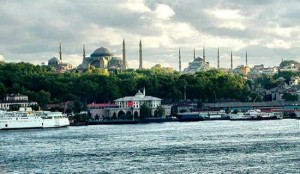
There are many places I visited in Istanbul but I will limit my story to two famous mosques, two palaces and two bazaars that represent Ottoman architecture and history very well. I went out every evening plus the last whole one day to visit these places. But I could only manage one palace, one mosque and one Spice or Egyptian bazaar. Luckily I had visited the remaining each in my last visit. Let’s start with the Mosques.
MOSQUES:
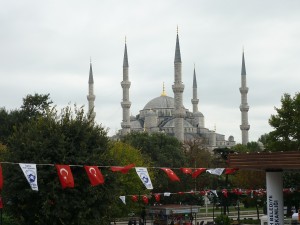
Turkish mosques have a distinct characteristic look, built in light grey, brown or cream stone with a big & high dome in the middle surrounded by small domes and 2, 4 or even 6 pillars on corners. The building appears very appealing and attractive. There will be a courtyard with ablution facility as you enter the gate. Roof & walls inside would be painted or decorated with fine tiles art work. Inner building would have ladies corner at the back.
One strange thing I noticed inside a Turkish mosque is that the azaan and aqamat (calls for prayer) are said from the back right corner where there is a small dedicated area occupied by the assistant imam. There are also chairs here for disabled. Irrespective of the mosque being full or otherwise, the deputy imam stays here; says azaan & iqama as well as prays from the same back right corner.
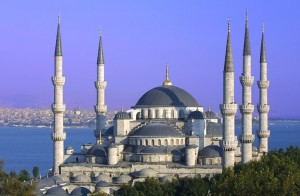
Sultan Ahmed or Blue Mosque: This is probably the most famous mosque (after Ka’aba, Masjid Nabvi & Bait Al Muqadas), especially among non-Muslims. Built in 1650s, it is huge in size. Its design is typical of Ottamani architecture. I fell in love with it & surroundings when I saw it in one of the James Bond cigarette ads filmed here. I am talking about years back when tobacco ads were allowed and we used to have them frequently during long cricket matches.
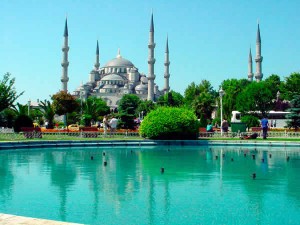
This mosque was built around 1616, its inner walls have blue tiles hence it became famous as Blue Mosque. It’s centre dome is 43 meters high, more than half of a hockey ground. Blue Mosque is surrounded by Basphorous on one side and a park on the other. Topkapi palace is nearby and so is similar looking but much older Hagia Sofia church. I went to visit the mosque with my American non Muslim colleague but it was closed due to a foreign delegation visiting it. There was a Pakistani politician also but I can’t remember his name.
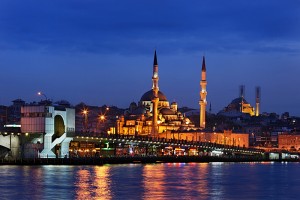
Yeni Camii or New Mosque: This is a real beauty. Started in 1597 & completed in 1665 on the corner of Egyptian Bazaar now known as Spice Bazaar. Its interior is really magnificent. It resembles to blue mosque but a bit less known and is a bit younger.
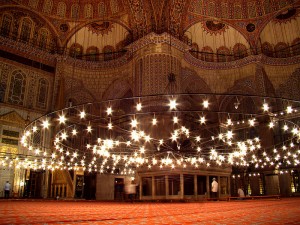
It is so graceful & beautiful that can’t be said in words. I took my colleagues from America, Serbia, Indonesia and Brundi for a visit; none had seen a mosque before. I am sure they were impressed by its glory.
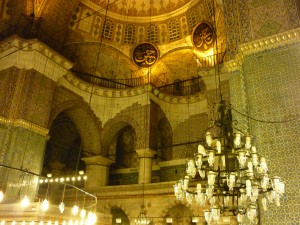
Ayup Mosque: Ayup Mosque was the first one built by Ottomans after conquering Istanbul & is named after Hazrat Ayub Ansari RA, the companion of Prophet Muhammad SAW. It is built next to the tomb where Ayub RA is said to be buried. I could not visit it though.
Palaces
Top Kapi Palace:
Fatih Sultan Muhammad known as Muhammed II, the conqueror of Constantinople started building the Sarayie Topkapi or Topkapi Palace in 1459. It remained the official house of Ottamani khulafa (called Sultans) for 400 years. This palace is huge which housed up to 4000 people at times. The name TopKapi Sarayei means Cannon Gate Palace, Cannon Gate was the name of a gate nearby which doesn’t exist anymore.
The palace became older over time and hence lost its charm for Sultans. New palaces were built along the Basphorous, and eventually in 1856 Sultan Abdul Macid I (Majid I) moved office to a newly built modern European style Dolmabache Palace. Topkapi Palace was turned into a museum in 1924 after the demise on Ottoman Empire. Most of it is closed to public now. The open-to-public rooms contain hundreds of articles belonging to Ottomans and Islamic history. It also contains some of Prophet Muhammad (SAW) belongings as well as of some other prophets AS. I visited it last time when I came here. It is the one of the most visited palace and is always crowded.
Dolmabache Palace:
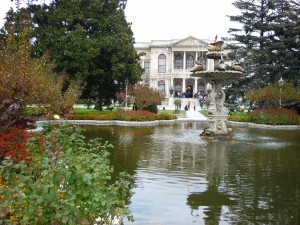
Built in 1856, it is one of the most spectacular palaces I have ever visited. It is the most recent, most modern & most magnificent out of Ottomani palaces. Dolmabache had central heating, initially through wood and then natural gas, telephone and electricity. The building is huge comprising of 285 rooms & 43 halls.
Dolmabache Palace was designed on western style yet Islamic culture is evident in it. It is divided into two distinct parts, one serves as office of the Khalifah or Sultan and is really glorious. Second part is for private use, sometimes referred to as Harem. It is used by the ladies of the house including the mother of Sultan. In fact valide sultan (mother) had the best & prominent apartment. Mother is given the most importance in a Muslims family. Mother’s apartment was between Sultan’s and his wives so she could watch & control who is visiting Sultan.
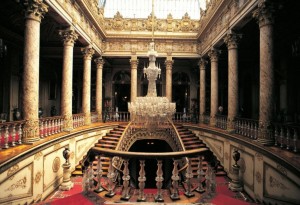
Each 3 storey apartment is complete with bed room, reception, maid’s room & wash room. Dinner room is communal. There is a guest apartment also but surprisingly there is no room for father or brothers. Perhaps they lived separately.
Khilafah Goes:
It was very emotional for me to see the room (now library) where last Khaleefah Sultan Abdul Majid II was told that you are not Khalifah anymore. I couldn’t stop my tears here; this is where Muslim nation lost their protection and ever since suffering all over the world. He was exiled to Switzerland. Mustafa Kamal then had his office & residence here. The room where Mustafa Kamal took his last breath is also nearby.
Our guide was a Young Turk lady. I followed her very closely to absorb as much history as possible. Khilafat was abolished in 1924 I enquired. She corrected me quickly that state & religion was separated in 1922, from then khalifah or Sultan became a symbolic religious figure. Mustafa Kamal took the political powers as President of Turkey. Khilafat was completely abolished in 1924.
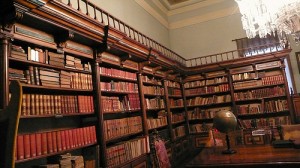
Religion & State (Politics) Separation
I don’t see any benefits in separating state & religion. This gives unlimited, unchecked powers to political leaders. They make the laws and do so in their favour. Can you imagine taking a modern day leader to court? All heads of state have immunity against wrongdoings. Under Islamic law, no one is above the law, not even Prophet Muhammad SAW. There are incidents when most prominent people like Umar RA & like were brought charges against and they had to face court. It was only possible because no one made the laws, rather everyone just followed the GOD-made laws. This is why we call Islam a deen – a complete way of life.
Money on Poor vs Money on Palaces
Nevertheless the palace is exceptionally elegant. Its cost was 5 million gold coins (35 tons of Gold) which nearly emptied the treasury. When leaders start spending such huge amounts of money on wasteful projects instead of spending on people, demise becomes inevitable. Ottoman empire soon vanished from map. Our good old leaders saw glory in serving people not in palaces. Umar RA stopped eating proper food when famine hit Madina, saying I will not eat until my people eat properly. Today, our people are hungry again, but our democratic leaders? Take for example, RS 74 million have been spent on renovating Prime minister Mr Syed Yousaf Raza Gilani’s office & house in 2 & half years. Supposedly he comes from Prophet Muhammad’s SAW family, who himself hardly ate full belly in his entire life.
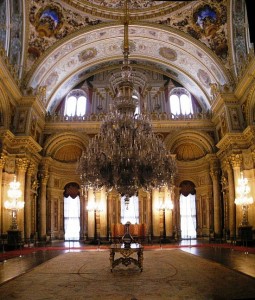
Sultans used to hold their courts here in its Grand Reception hall. Its domed roof is 36 meters high of which hangs the biggest Bohemian glass chandelier in the world weighing 4000 kg (4.5 tons). There are balconies all around about 20 metres high which were used to seat dignitaries and foreign visitors. No one would sit at the back of Sultan (perhaps to safeguard from back stabbing!). The hall is still used as an official reception for head of states. The chandelier is turned on only then.
Spice or Egyptian Bazaar:
Completed at the same time as Yeni Mosque, in fact its building is part of the mosque and money raised from here used to support maintenance of the mosque. The bazaar sold spices mainly coming from Egypt, therefore it was called Misir (Egypt). This bazzar has been the centre of spice trade and hence also known as Spice bazaar. It is an L shaped covered building which is usually very crowded. Other than spices you can buy Turkish delight, baklawa, fruit and nice Turkish decorations, and indeed I did so. My Brundi (now living in France) colleague bought a big red pomegranate (anaar) for reasons unknown. Maybe these are not available there.
Grand Bazaar:
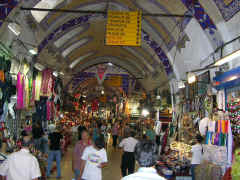
This is the largest & oldest covered bazaar in the world. It was opened in 1461 and has more than 1200 shops selling jewellery, clothes, fruit, leather stuff, carpets & spices. Always busy always crowded, it attracts up to 400,000 shoppers a day. I bought a leather jacket from here during my last visit. The shop keeper offered Turkish apple kahva (tea), the sweet aroma is still fresh in my mind.
The end. Please Read Part 1 here
Truly the grandeur is awe inspiring!